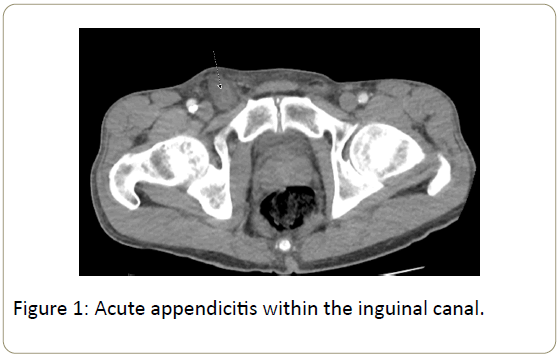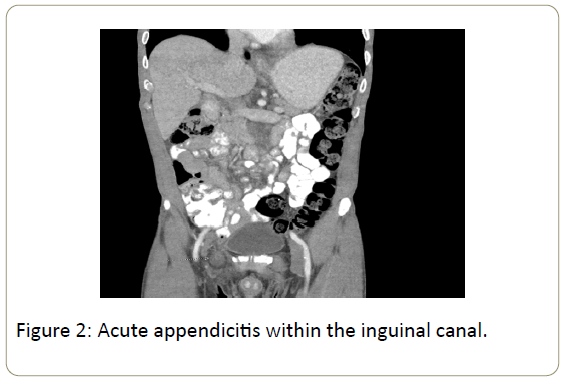Acute tip appendicitis contained within a right sided inguinal hernia (Amyand's Hernia): a case report
New York College of Osteopathic Medicine Medical School, USA
- *Corresponding Author:
- Christine Wagner
New York College of Osteopathic Medicine Medical School
USA
Tel: +9526490151
E-mail: christinewagner1290@gmail.com
Received date: Apr 03, 2017; Accepted date: Jul 10, 2018; Published date: Jul 17, 2018
Citation: Wagner C, Morin N, Smit P, Kopatsis A (2018) Acute Tip Appendicitis Contained within a Right Sided Inguinal Hernia (Amyand's Hernia). J Surgery Emerg Med 2: 18
Copyright: © 2017 Wagner C, et al. This is an open-access article distributed under the terms of the Creative Commons Attribution License, which permits unrestricted use, distribution, and reproduction in any medium, provided the original author and source are credited.
Abstract
This patient is a 64 year old male with a PMH of depression, anxiety, COPD, gastritis, and previous right inguinal hernia repair who presented to the emergency room with one day of right groin pain that occurred suddenly the night before. He has never experienced pain like this before and over the counter analgesics did not relieve the pain. Patient states that the pain is associated with a small budge in the right groin that is tender to palpation [1]. On physical exam patient had a soft and non-tender abdomen. An exquisitely tender 2cm x 2cm palpable nodule in the right groin was noted.
Image Article
This patient is a 64 year old male with a PMH of depression, anxiety, COPD, gastritis, and previous right inguinal hernia repair who presented to the emergency room with one day of right groin pain that occurred suddenly the night before. He has never experienced pain like this before and over the counter analgesics did not relieve the pain. Patient states that the pain is associated with a small budge in the right groin that is tender to palpation [1]. On physical exam patient had a soft and non-tender abdomen. An exquisitely tender 2 cm 2 cm palpable nodule in the right groin was noted. CT scan of the abdomen showed a right sided inguinal hernia containing the appendix with acute tip appendicitis. Inguinal hernias containing the appendix are rare and are referred to as an Amyand hernia. These are usually found during routine inguinal hernia repairs and are a curiosity for the operating surgeon, but there is little change in the operative management of an open hernia repair when the appendix is easily reducible. Rarer still is the finding of acute appendicitis contained within an inguinal hernia (Figure 1). This finding complicates the management and challenges the surgeon’s creativeness [2]. The standard of care for acute appendicitis is laparoscopic removal of the appendix. Whereas the standard of care for inguinal hernia repair is reduction of the hernia sac and mesh repair. A mesh cannot be used in the setting of inflammation, as such is that case with acute appendicitis.
In this case, the acute appendicitis was the more pressing pathology. It was decided to approach via the standard laparoscopic method used for acute appendicitis. The hernia was easily reduced from the abdominal cavity and the appendix was excised in the usual manner. Pathology report showed acute appendicitis [3]. Due to the acute inflammation, the decision was made to not repair the hernia, and instructed the patient to return for follow-up where an elective inguinal hernia repair with mesh would be planned (Figure 2).
References
- Barillaro I, Di Patrizi MS, Boccolini A, Avenia S, Polistena A, et al. (2015) A rare case of Amyand's hernia in a 67-year-old male. A case report and review of the literature. Int J Surg Case Rep 24: 86.
- Karanikas I, Ioannidis A, Siaperas P, Efstathiou G, Drikos I, et al. (2015) Incarcerated Amyand hernia with simultaneous rupture of an adenocarcinoma in an inguinal hernia sac: a case report. J Med Case Rep 28: 120.
- Weledji EP, Mokake M, Ngowe MN (2014) A Rare Presentation of Maydl's Hernia. Case Rep Surg 1-3.
Open Access Journals
- Aquaculture & Veterinary Science
- Chemistry & Chemical Sciences
- Clinical Sciences
- Engineering
- General Science
- Genetics & Molecular Biology
- Health Care & Nursing
- Immunology & Microbiology
- Materials Science
- Mathematics & Physics
- Medical Sciences
- Neurology & Psychiatry
- Oncology & Cancer Science
- Pharmaceutical Sciences


